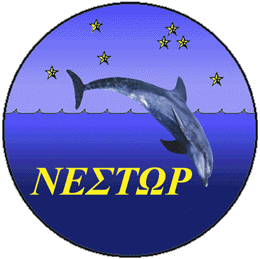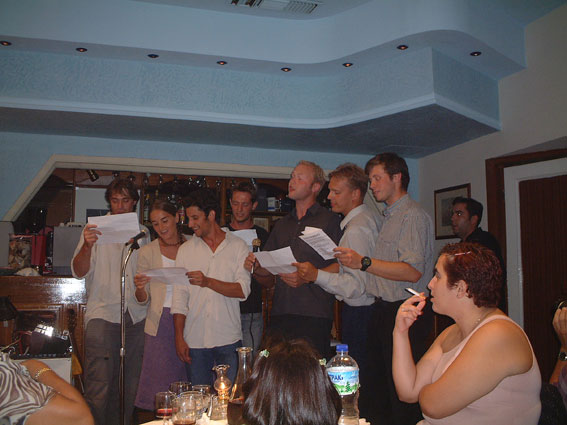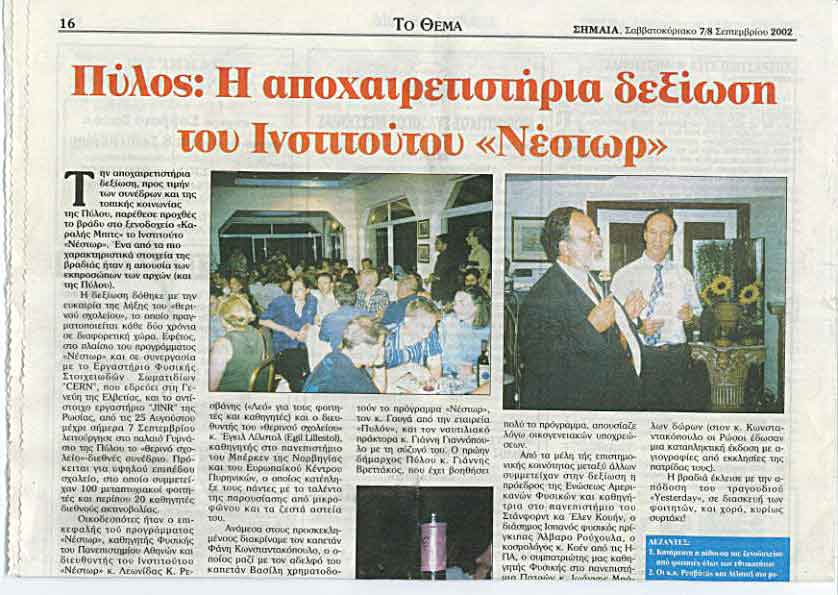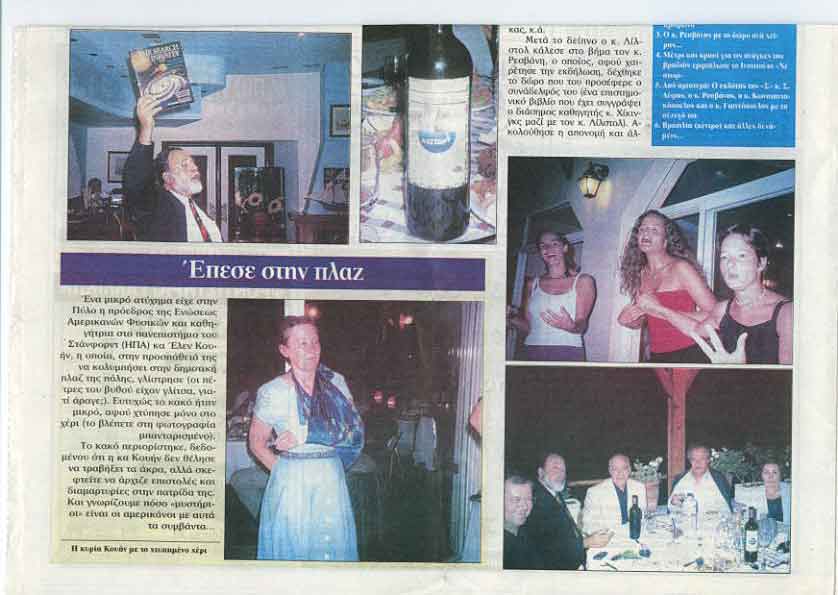 |
 |
 |
 |
 |
 |
THE SCHOOL
The tenth in the new series of the European School of High-Energy Physics, which took place in Pylos, Greece, from 25 August to 7 September, was attended by ninety-six students coming from thirty different countries, and had an all time attendance record of thirty-six female students. The School was organized at the Nestor Institute with its director, Professor Leo Resvanis, also acting as local director for the School.
The School participants were lodged in five different hotels, keeping the tradition of twin rooms for the students, mixing nationalities and in particular having Eastern students sharing rooms with Western students. This led to the usual complaints at the beginning of the school, but was, again as usual, very well appreciated at the end of the school.
Lunch tickets, which gave access to four different restaurants, was a novelty this year and was highly appreciated. However, dinner was the time for everybody to be together at the Karalis Beach Hotel.
All the lectures were held in the conference room in the dungeon of the “New” Castle built in 1573 by the Turks and called Niokastron, an extraordinary place, overlooking Pylos and dominating the former "Town gymnasium" now hosting the Nestor Institute.
The students displayed their work in the form of posters on a special evening session the first week. The posters were pinned on the walls of the Nestor Institute, and due to its success were kept up for the whole remaining part of the School.
EXCURSIONS
The School participants also enjoyed several memorable excursions:
One was by boat on in the Bay of Navarino with a first stop at the Island of Sphacteria, the scene of the famous naval battle in October 1827 which put an end to the war between the Greeks and the Turks. Monuments dedicated to the allied fleet (English, French and Russian) could be visited, and a small Eastern delegation put flowers on the Russian monument raised in honour of the Russian Vice Admiral Heyden. Next stop was a lovely beach in the bay of Voidokilia at the foot of hill where the Old Castle of Navarino - called Palaiokastron or Palaionavarinon – is built.
For some of the students this was an opportunity of having swimming lessons and for most of the others of enjoying long swim in the clear, blue sea. The most courageous climbed the hill up to the Castle ruins overlooking the bay.
On the middle Sunday there was a full-day excursion first to the archaeological excavations of the Palace of NESTOR (close to Englianos), followed by a visit to the Archaeological Museum of Chora Trifylia, and finally to Ancient Olympia.
Professor Korres was our guide at the Nestor Palace probably built by Neleus, the father of Nestor, at the beginning of the 13th century B.C. It was both the seat of the ruler, the administrative centre of a basically agricultural region, and the co-ordinating center of the economic activities of the region. Amongst the most important finds from the Palace are the Linear-B Tablets, giving information about the Linear-B alphabet.
The Chora Museum.
This beautiful Museum contains antiquities from important Mycenaean sites distributed over a large part of the county of Messenia especially from the Royal Tholos Tombs in the area of Englianos (1900 - 1200 BC).
Ancient Olympia.
The Archaeological Museum displays famous finds from the area, and amongst them is the stone head of Hera, Praxiteles' marble statue of Hermes (330 B.C.). There are indications that athletic games were already being held in 1000 B.C., but 776 B.C. is the date of the first Olympiad dedicated to the honour of Zeus. From then on every four years, pan Hellenic contests were held attracting athletes from all the Greek city-states. While the Games were taking place, the Olympic Truce was in force and all hostilities were suspended. The victor's prize was a crown made of a wild olive branch always cut from the same tree, the Kallistefano. The world wide known archaeological site is impressive. Some courageous students had a run the length of the Olympic stadium, and their performances are certainly immortalized on some of the pictures.
Last Wednesday excursion to Ancient Messini.
The City of Ancient Messini was protected by a circular wall parts of which, and in particular the massive gates, are still standing. The wall was 9 kilometres long and 3 metres wide. It is considered one of the finest examples of military architecture of the 3rd and 4th century BC. A guided tour was organized, showing the heart of the walled city which lies at the spot today occupied by Mavromati , 32 km from Kalamata. Mavromati is a small village built like an amphitheatre at the foothill of the sacred mountain of Ithomi where, according to a legend, Zeus was born. Ancient Messini has temples, a theatre, stadium and a cemetery, not to mention houses. The excavations constitute an important archaeological entity, and part of them are displayed in a small museum in the village.
HAPPY ENDING
During the School participants enjoyed the nearby sea and a lot of them will have memories of swimming, especially at midnight! On the last evening the traditional Farewell Banquet was celebrated at the Karalis Beach Hotel. A few representatives of the local authorities were invited and introduced by Leo to share with the School participants various and delicious dishes accompanied by local red and white wines especially bottled with a special label dedicated to the School! Leo Resvanis and Egil Lillestol, Director of the CERN Schools, both gave pleasant farewell talks. Anecdotes collected during the two weeks of the School were turned into reasons to congratulate some "deserving" students, and small prizes were offered by JINR and CERN.
The dinner was animated by a local band using traditional Greek instruments and playing nice folk melodies and famous Greek songs until late into the night.
Some students had prepared sketches, and Sophia gave a performance of belly dancing demonstrating that clever physics students have time for more than physics. A “sirtaki” lesson was given by a female Greek student together with the ever present and helpful Antonis from the Nestor Institute.
Based on Beatles music a song composed for the occasion by the CERN/JINR Summer School Students 2002 (Troels & Co.) is reproduced below :

School Poetry
Yesterday, Supersymmetry was far away
Standard Model seemed as here to stay
First we believed in
Yesterday
Suddenly, Pylos really was the place to be
The Higgs potential we clearly see
Oh yesterday, came suddenly
Gin and tonic goes well
with swimming night and day
John and Egil naked -
We long for yesterday
Yesterday, we were dreaming of proton decay
CP seemed an easy game to play
But that was only yesterday
We go out all night
Try not sleeping during day
We drank something wrong
Now we long for yesterday
Suddenly, LHC has luminosity
Symmetry at high energy
Oh, we believe in QCD
It's been hard and tough,
for the breaks we've had to pray
It's been great and we'll miss it
When we go away ....
Our warmest thanks go to the NESTOR team, the local staff in the hotels and restaurants, to all the participants (the lecturers, discussion leaders, students and organizers).
The links listed below will help you to keep active memories from both working hours and freetime.
Press Coverage


This was a GREAT School.